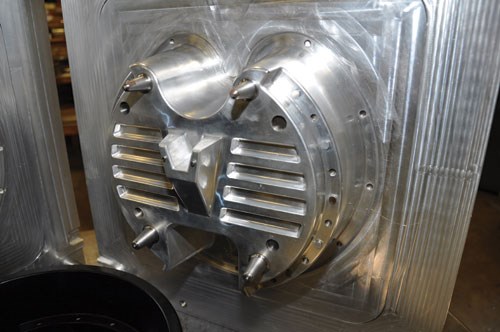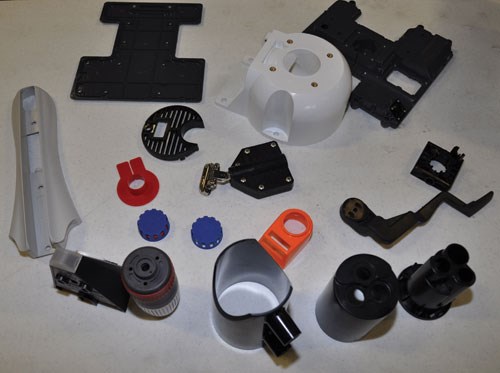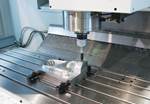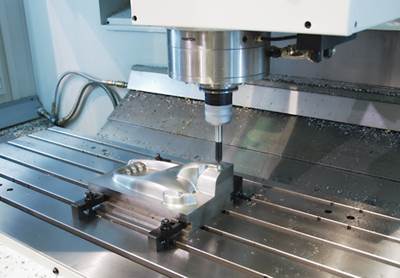Technology Investment Pays Off for New England Moldmaker
For Wepco, the reward of reduced cycle times and increased productivity, which enabled them to book more jobs per week without sacrificing quality, was worth the risk.
Established in 1985, Wepco Plastics specializes in short-run prototype injection molds in aluminum and steel. The company has grown to more than 45 employees who work at the 10,000-square foot facility in Middlefield, CT In the fall of 2008, Wally and David Parmelee (Wepco owners) found themselves at a cross roads in terms of milling capac¬ity for their toolroom.
Should they continue with their current milling technology (a known quantity with zero learning curve) or invest in the future by purchasing a higher performance machine? They knew this decision would impact their tooling and in-house molding business for many years to come. Introducing new technology to a shop always presents a learning curve, which is an inherent risk, but new technology can also promote growth. For Wepco, the reward of reduced cycle times and increased productivity, which enabled them to book more jobs per week without sacrificing quality, was worth the risk.
Pre-Purchase: Identify What Matters
When Wally and David decided to break stride with their current equipment and pur¬chased a Hurco VMX30 machining center from Brooks Associates (Norwell, MA), four factors were paramount to their decision-making process: a control with an open architecture, mechanical design, local service and customer references.
1. The Control: open architecture vs. closed architecture
As Wally and David evaluated control technology, they realized the importance of investing in a control with an open-architecture because it is more likely to be compatible with future technology. The integrated Hurco control has a Windows®-based operating system, which means they can easily add automation products in the future if their business warrants it. Additionally, Wally and David understood the value of an integrated control that is specifically designed to work with the machine tool’s motion control system. Not only does it enhance performance, but it makes service one stop. Control features with measurable benefits, such as Hurco’s proprietary advanced motion control, were also important to Wally and David.
2. Mechanical Design
The mechanical design is obviously important to any shop owner. Standard specifications, such as travels and rapids, are easy to compare from one machine tool builder to the next, but sometimes it’s harder to evaluate “what’s under the hood.” With the Hurco VMX30, Wally and David felt the design details Hurco incorporates into its manufacturing process promote rigidity and reliability. The linear rails are larger, and strategically spaced for increased strength. Additionally, Hurco wedge locks the rails to a machined shoulder, which makes the machine more robust, instead of simply mounting them to a single surface. The double-nut, pre-tensioned ball screws are anchored at both ends for increased accuracy and rigidity. A dual-wound 12K spindle delivers the cutting power they need.
3. Service
Local support and service is important for any purchase, but it’s critical to have reliable service people you trust when you have a small business. Brooks Associates has been a Hurco distributor for more than 30 years and they have thousands of units throughout New England. The peace of mind that comes with quick and affordable service they can get from Brooks was important to Wepco.
4. References. Marketing is always important to build/maintain awareness, but nothing can replace first-hand positive feedback from actual customers. Since Brooks has so much experience in the region, they have numerous customers who are happy to talk to other machinists about their experiences.
Can You Measure the Benefits of New Technology?
The decision to move forward and invest in new technology proved advantageous for Wepco. The Hurco VMX30 delivered superior performance and part quality in a fraction of normal cycle times. Wepco primarily focuses on aluminum molds for prototype and short-run batches. The dual-wound, 12,000-rpm spindle of the Hurco VMX30, coupled with Hurco’s new motion control system called UltiMotion™, drastically re¬duced total part cycle time by as much as 200-300 percent in some cases with no loss of accuracy or finish. Before UltiMotion™ Wepco would finish machine at 40 ipm. With UltiMotion, they are able finish machine at rates from 125-350 ipm!
According to David, he thinks the productivity will just get better, “We have really started to focus on pushing the machines to see what they can really do, and I have to tell you that every day we do something that just blows us away. With the UltiMotion (Soft motion) along with tweaking our post to make segmented or linear moves, we are achieving extremely high feedrates up to 800 ipm. As an example, we had a cut that would have been at least 100 hours long on our old machines that we did in 30 hours and I believe that we could even cut that in half. We finish cut the cores with a .0469 end mill ground back .500 at 100 ipm. We could have easily doubled the speed and got the same results. And I don't have to polish the mold! The finish is that good!”
These productivity gains yield increased profit margin for existing jobs and additional capacity due to increased throughput. For example, a 30 percent productivity gain turns a 40 hour work week into at 52 hour week in terms of throughput with zero overtime for labor and zero increase in debt service on the equipment.
The VMX30 also offered opportunities for Wepco to expand its capabilities. For example, due to the rigidity and spindle speed of the VMX30, they can do hard milling on inserts. Wepco routinely machines 58 Rc mold inserts made from S7 tool steel. Parts come off the machine ready for assembly in the mold. Success with this type of material is due to advanced cutter technology and the Hurco UltiMotion™ software, which optimizes machin¬ing rpm and feedrates based on part geometry. UltiMotion™ routinely reduces cycle times on 3-D programs by as much as 40 percent.
How UltiMotion Works
According to Hurco engineers, this new technology uses the power of software for motion control instead of relying on hardware. The secret to UltiMotion is the advanced trajectory algorithm in the software that generates significantly faster yet smoother motion than any hardware-only solution. While there are numerous technical details, some of the straightforward results include cornering velocity that is 2.5 times faster than conventional motion, 50 percent less machine jerk, and a patented dynamic variable lookahead mechanism that doesn’t require a fixed number of blocks. Instead, the control evaluates the geometry and motion profile and makes sure there is enough look-ahead information to make optimized maneuvers. This look-ahead mechanism of UltiMotion is another reason why better surface quality can be obtained in a shorter period of time.
Going Forward
Wepco was so encouraged by the productivity of the VMX30 that they added a second Hurco VMC shortly thereafter (Hurco VMX24). Both ma¬chines have proven to be reliable sources of production for Wepco’s toolroom as they continue to grow. Wepco attributes this growth to detail and quality, as well as customer satisfaction by diligently following specifications, meeting delivery dates and offering competitive prices on short run injection molding.
Windows® is a registered trademark of Microsoft Corporation in the United States and other countries. UltiMotionTM is a trademark of Hurco Companies, Inc.
For More Information:
WEPCO Plastics, Inc.
(860) 349-3407
www.wepcoplastics.com
info@wepcoplastics.com
Brook Associates
(781) 871-3400
Brooks Associates
sales@brooksmachinery.com
Related Content
Questions and Considerations Before Sending Your Mold Out for Service
Communication is essential for proper polishing, hot runner manifold cleaning, mold repair, laser engraving and laser welding services.
Read MoreThe Role of Social Media in Manufacturing
Charles Daniels CFO of Wepco Plastics shares insights on the role of social media in manufacturing, how to improve the “business” side of a small mold shop and continually developing culture.
Read MoreMMT Chats: Eliminating the Noise to Stay Focused on the Customer
Metro Mold & Design joins me to discuss the value of the 80/20 rule as a business strategy, its talented cross-functional team, the role of automation in mold building and molding, and the continuing impact of COVID-19.
Read MoreMMT Chats: 5 in 5 with Best Tool and Engineering
MoldMaking Technology Editorial Director Christina Fuges reveals 5 best practices for improving efficiencies within shops...in 5 minutes. Our guest is Joe Cherluck, President of Best Tool and Engineering in Clinton Township, Michigan.
Read MoreRead Next
How to Get the Most Out of Your Control
If the spindle is the heart of the machining center, the control is the brain. This article will help you explore whether it’s time to expand your brain and find new efficiencies to increase profitability.
Read MoreAre You a Moldmaker Considering 3D Printing? Consider the 3D Printing Workshop at NPE2024
Presentations will cover 3D printing for mold tooling, material innovation, product development, bridge production and full-scale, high-volume additive manufacturing.
Read MoreHow to Use Continuing Education to Remain Competitive in Moldmaking
Continued training helps moldmakers make tooling decisions and properly use the latest cutting tool to efficiently machine high-quality molds.
Read More

























